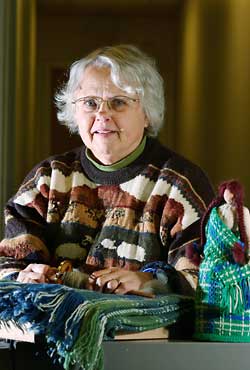“It all started with that dog,” says Kate Carras.

More than 27 years ago Carras, now the assistant registrar at the Kelsey Museum of Archaeology, received a Border collie puppy, a sheep-herding breed.
To keep the puppy entertained, Carras found sheep for the dog to chase.
Carras soon discovered she liked having sheep. But there was a dilemma: What could she do with the wool sheared once a year from the animals?
Her solution was to get a spinning wheel and take a class to learn to spin the wool into yarn. Soon, the hobby became a passion, working its way into her professional life. At the urging of friends from her spinning guild, Carras went back to college to earn a fiber arts degree, which helped her land her current job at the Kelsey Museum. For the last 4 1/2 years, Carras has worked with ancient textiles, which she finds especially exciting.
“It’s a connection to the past, which makes working here so cool,” she says.
She so enjoyed learning about this art form while earning her bachelor of fine arts degree from Eastern Michigan University that she went back to receive her master’s degree as well.
Carras says it took her a while to catch on to spinning but now the process is second nature. “Once you get comfortable spinning, it almost becomes meditative. It’s a very relaxing time,” she says. Carras now owns a couple of spinning wheels and a number of drop spindles. She especially enjoys having control over each step of the process in making a finished product, such as a wall hanging, an article of clothing or her favorite—a doll.
Carras specializes in doll making, and says her creations have evolved from very simple designs to much more complicated patterns. She sells her dolls at various fairs between Michigan, Ohio and Maryland. She also has taught doll-making classes and enjoys sharing her skills with a group called Looking Glass Dolls, and with her spinners group called the Spinners’ Flock. Several other U-M staff, including Robin Meador-Woodruff, a fellow Kelsey Museum employee, are members.
Carras loves to learn new techniques, so she usually takes one class a year to expand her repertoire.
The process requires mastery over a few tasks at once. A spinner must constantly use her foot to propel the wheel, which twists the fibers, while at the same time feeding the fleece into the machine with her hands. Controlling her feet while doing something entirely separate with her hands took Carras some time to learn. She spins the yarn onto bobbins, or spools that catch it for use later.
When Carras first learned to weave, she discovered she liked tartan— the colorful, plaid textile design that provided a connection to her Scottish heritage. “I was determined I was going to weave a hand-spun, hand-died Scottish tartan shawl,” she says.
Another accomplishment of which Carras is particularly proud was having a feature article in 2004 in Spin-off, an international magazine. In the future she may write a book about her spinning experience.
The fiber she usually spins comes from sheep, and Carras sometimes opts to spin straight off the sheep’s back after washing and carding the wool. Although wool remains her favorite, she ventures occasionally to spin different fibers such as alpaca, goat, rabbit, or musk ox. “It’s fun to experiment with these odd fibers,” she says.
Carras credits encouragement from friends for how far her hobbies have taken her but stresses she owes a great deal of thanks to her departed four-legged friend. “I don’t know what I would do if I couldn’t spin, or weave or knit,” she says, remembering the dog that started it all.

